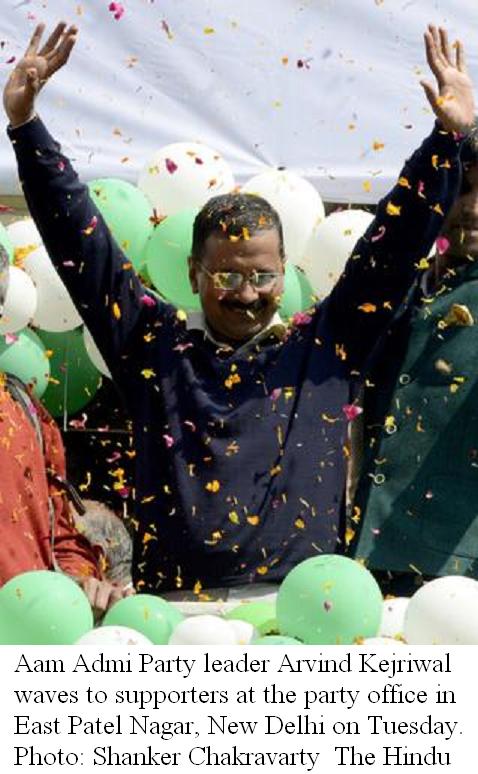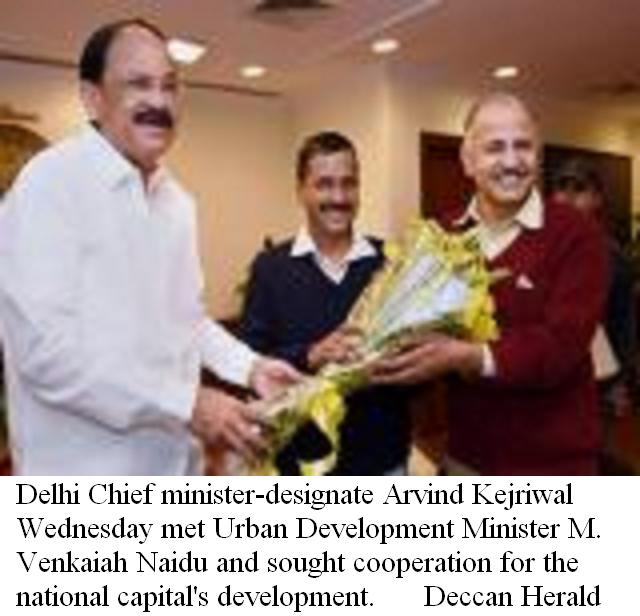|
||||||||
|
|
|
2015-02-20 ArtNo.45436
◆AAP ki sarkar: Kejriwal rules Delhi
 【New Delhi】The Arvind Kejriwal-led Aam Aadmi Party on the 10th February swept to power with 67 seats in the 70-member Delhi Assembly, leaving only three to the Bharatiya Janata Party which had won all seven Lok Sabha seats in May 2014 and nil to the Congress which had been in power for three consecutive terms in the State until 2013. Scripting a new political narrative, Arvind Kejriwal's royal come back leading the AAP to a spectacular victory, reflects his strong positioning as a "change agent" that scuppered BJP's bid to power in the national capital and put a break on the Modi juggernaut. The 46-year-old bespectacled IITian, notwithstanding a string of electoral triumphs for BJP since the May Lok Sabha polls, managed to anchor a campaign that wooed all sections in the city and quietly spread his party's wings after the Lok Sabha poll debacle, and finally achieved the extraordinary feat. ○Kejriwal, Naidu discuss Delhi's development  【New Delhi】Delhi Chief minister-designate Arvind Kejriwal on the 11th of February met Urban Development Minister M. Venkaiah Naidu and sought cooperation for the national capital's development. Accompanied by Aam Aadmi Party leader Manish Sisodia, Kejriwal met Naidu at Nirman Bhawan - which houses the ministry - around 9.30 a.m. Assuring to work without any political divide between AAP-led Delhi and the BJP government at the centre, Kejriwal sought help from the ministry over the issue of squatter colonies. ○For AAP, changing perception was bigger challenge than BJP  【New Delhi】The results are out, and the Aam Aadmi Party’s (AAP’s) thumping victory in the Delhi Assembly election is mainly being attributed to the collective failure of the Bharatiya Janata Party’s (BJP’s) national and state leadership. This, however, might just be half the story. The AAP leaders believe BJP had lost the plot much before the elections were announced. “It all began when we started holding the mohalla sabhas (neighbourhood committees) and went back to the people,” says Ashish Talwar, AAP’s Delhi unit incharge who restructured the party and was one the faces behind AAP’s successful comeback. After being tagged a ‘fugitive’ party, it had become important for AAP to regain the lost faith among the citizens of Delhi. So, the prime battle for AAP was bringing about a change in perception of itself. Immediately after the party’s Lok Sabha debacle, AAP’s top leadership instructed its 27 members of the Delhi Assembly to hold mohalla sabhas (neighbourhood committees) in their respective constituencies — the sole purpose was decentralisation of decision-making at the ground level. ○The obvious and not-so-obvious reasons for AAP victory  【New Delhi】First the obvious. The surprising part of the result is not the victory of the AAP but the huge margin. This clearly indicates that this is not a negative vote. There are two important reasons for the AAP victory. The first is that a great majority of Delhi – especially the deprived – found the 49-day government to be one which had yielded positive results: petty exactions by police and government personnel had disappeared, electricity and water bills were favourably impacted for the consumer. Retrospectively this seems to have produced a sense that AAP provided a representative party of governance and was not just a party of Opposition. The second important feature is that AAP not only managed to survive the Lok Sabha verdict but actually consolidated their organisation. 【News source】 AAP ki sarkar: Kejriwal rules Delhi Delhi poll results: Arvind Kejriwal positions himself as a 'change agent' Kejriwal, Naidu discuss Delhi's development For AAP, changing perception was bigger challenge than BJP The obvious and not-so-obvious reasons for AAP victory AAP humiliates BJP in Delhi: 5 points why Narendra Modi will rush economic reforms Delhi cheers as Kejriwal ‘returns home’ SEAnews eBookstoreSEAnews eBookstore(GoogleE)Readers' VoiceYour Comments / UnsubscribePlease do not directly reply to the e-mail address which is used for delivering the newsletter. SEAnewsFacebookSEAnewsGoogle |
|
[Your Comments / Unsubscribe]/[您的意见/退订]/[ご意見/配信停止]
Please do not directly reply to the e-mail address which is used for delivering the newsletter. 请别用递送新闻的邮件地址而直接回信。 メールをお届けした送信専用アドレスには返信しないで下さい。 |